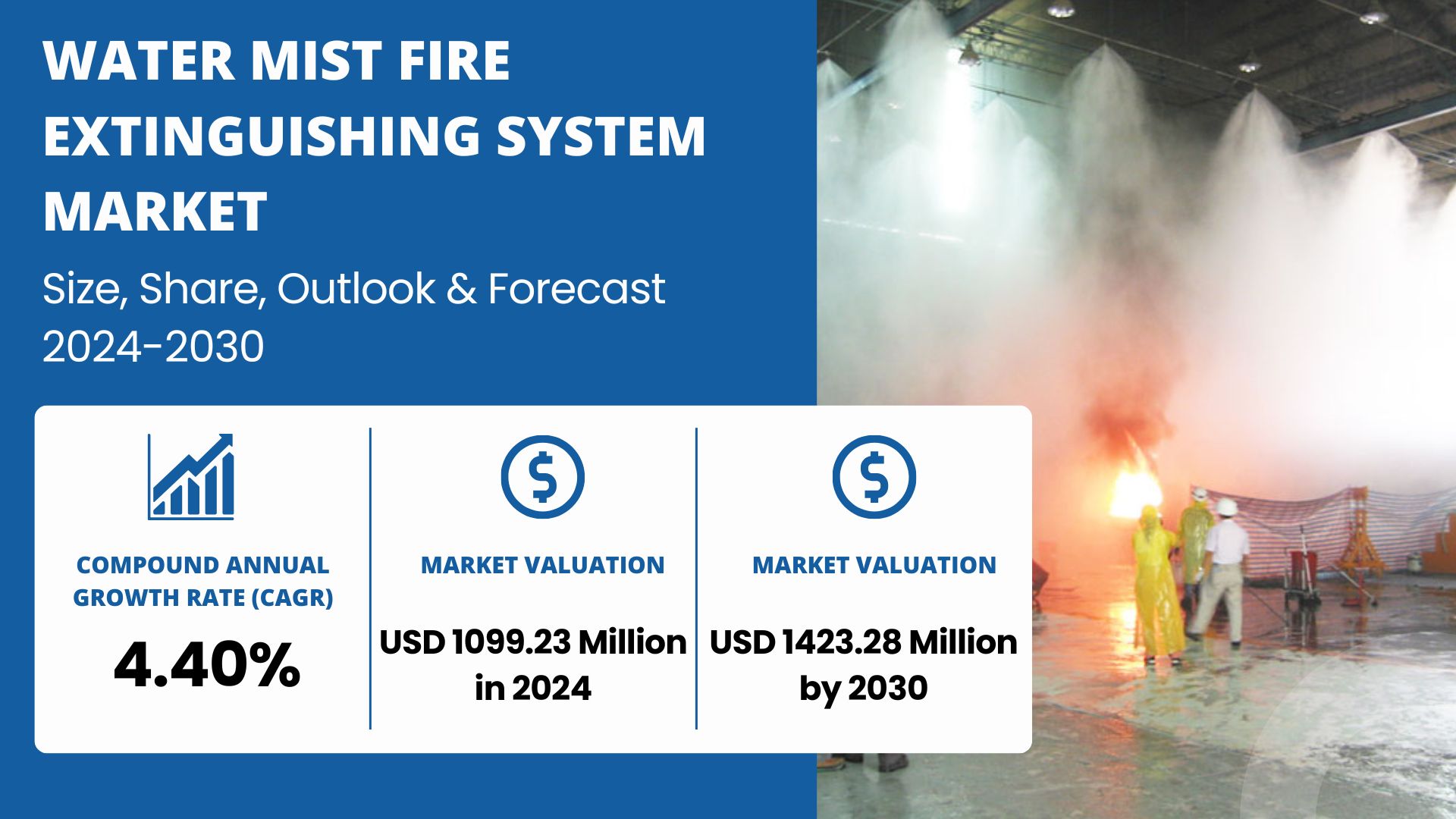 Click for best price
Click for best price
The "Global Water Mist Fire Extinguishing System Market" Size was estimated at USD 1099.23 million in 2024 and is projected to reach USD 1423.28 million by 2030, exhibiting a CAGR of 4.40% during the forecast period.
Water Mist Fire Extinguishing Systems are a new technology in the development of automatic extinguishing systems. In contrast to conventional sprinkler systems, this system uses the volume of finely atomized water dispersed in close proximity to the flame creates a high quantity of water vapour, which displaces the surrounding air and thus its oxygen, choking the flame. Nowadays water mist fire extinguishing system has become one of the most environmentally friendly fire protecting systems in the market and it is widely used in Public Buildings, Healthcare Institutions, Data Centres, Factories, Laboratories and other fields.
The global water mist fire extinguishing system industry is experiencing steady growth, driven by increasing demand for more sustainable and efficient fire suppression solutions across various sectors. Compared to conventional sprinkler systems, water mist technology employs fine water droplets to cool and displace oxygen, putting out flames. It is becoming more popular since it consumes less water, causes less damage to property, and is better for the environment. In sectors including data centres, healthcare, oil and gas, and marine where preventing collateral damage and ensuring fire safety are crucial, this method is extensively used. The industry's expansion is also being aided by fire safety regulations and increased awareness of environmentally friendly fire control techniques. In order to take advantage of new prospects, major market players are concentrating on technological advancements, integrating with smart fire detection systems, and entering growing markets. Widespread adoption may be hampered, nevertheless, by high installation costs and little awareness in some areas.

In terms of type, the global water mist fire extinguisher has been segmented as High-Pressure Water Mist System, Medium or Low-Pressure Water Mist system.
High-pressure water mist systems usually have a larger market share than medium- and low-pressure systems in the global market for water mist fire extinguishing systems. This dominance emerges from its capacity to quickly cool the fire zone, displace oxygen, and minimise radiant heat, as well as its efficacy in mitigating a wide range of fire types, including Class A, B, and C fires. In vital industries like data centres, oil and gas, maritime, and healthcare, where accuracy and less water damage are crucial, high-pressure systems are especially favoured. Even though they cost more to install than medium and low-pressure systems, they are more appealing due to their better performance, capacity to reach difficult-to-reach places, and low water consumption.
Although they are more affordable and appropriate for some uses, medium and low-pressure systems typically operate in less demanding settings, which reduces their market share overall.
In terms of application, the Global Water Mist Fire Extinguisher System Market has been segmented as Public Buildings, Factories, Transportation, Energy, IT and Communication, and Others.
The global water mist fire extinguisher system market is being dominated by public buildings in terms of application. This segment includes offices, hospitals, hotels, schools, museums, and commercial complexes, where fire safety is a critical concern, and the water mist system's ability to minimize water damage is particularly valued. The widespread adoption of these buildings is being driven by the stricter fire safety regulations, higher occupancy, and the need to protect both people and valuable property with minimal operational damage. Other application segments like factories and energy also represent significant portions of the market, particularly where there are higher fire risks. However, they are often more niche compared to the broader, more diverse category of public buildings. Transportation, IT and Communication, and other sectors like marine contribute notably but do not dominate as much as the public building sector.
North America follows closely, particularly in sectors like healthcare, data centres, and commercial buildings, where minimizing water damage is critical. The Asia-Pacific region is witnessing rapid growth, driven by increasing urbanization, infrastructure development, and industrial expansion in countries like China, India, and Japan. This region is expected to grow significantly as fire safety regulations tighten and industries prioritize sustainable fire suppression methods.
Middle East & Africa and Latin America are emerging markets, where adoption is slower due to lower awareness and infrastructure challenges, though growth is anticipated as awareness increases and regulations evolve.
The market for water mist fire extinguishing systems is extremely competitive worldwide, with major competitors fighting for market dominance through product diversification, innovation, and geographic growth. Despite difficulties with distribution and brand awareness, smaller and regional businesses are succeeding by concentrating on specific markets and providing affordable solutions. The growing need for ecologically friendly fire suppression technologies is also escalating market competitiveness, encouraging businesses to spend money on research and development to create more effective, water-efficient systems. Established businesses frequently use partnerships, mergers, and acquisitions to enhance their market positions and enter emerging markets in the Middle East, Asia-Pacific, and Latin America. These regions offer substantial growth prospects because of increased industrialisation and more stringent fire safety laws.
Oct. 17, 2024, Sensitech and Qualcomm Technologies, Inc. announce a strategic collaboration to further develop technologies to advance real-time monitoring solutions.This collaboration leverages the strengths of both industry-leading companies to deliver innovative real-time visibility and analytics solutions on a global scale
July, 10th 2024, Danfoss inaugurates new production facilities in Mexico to further regionalize supply chains and be closer to our customers. Danfoss extends its manufacturing footprint in Mexico by 40,000m² at its Monterrey Campus to further strengthen its position, increase supply chain resilience, and be closer to our customers in Mexico and the Americas.
Because water mist systems are so successful at preventing fires in areas where sensitive electronic equipment is common, they are becoming more and more popular in the commercial sector, which includes offices, hotels, and data centres. The system is perfect for safeguarding vital infrastructure, such as server rooms and telecom facilities, because of its low water discharge, which helps avoid collateral damage. Growing knowledge of cutting-edge fire safety systems and more stringent construction rules in developed areas are also driving interest in the residential sector. Another important end-use sector is transport, which includes rail and the sea. Because of its small size, minimal water usage, and capacity to safeguard enclosed areas like as train compartments or ship cabins, water mist systems are preferred. The market for water mist fire extinguishing systems is anticipated to grow as a result of increased demand from all of these industries due to stricter safety standards and a greater emphasis on sustainability.
Growing Emphasis on Environmental Sustainability Water Conservation in Fire Protection
The increasing focus on water conservation and environmental sustainability in fire safety is one of the major factors propelling the market for water mist fire extinguishing systems. Sprinkler systems and other traditional fire suppression techniques frequently consume a lot of water, which can cause significant water damage and increase the expense of cleanup, especially in sensitive locations like data centres, libraries, and historic buildings. In contrast, water mist systems use tiny water droplets to effectively put out fires while using a lot less water. This lessens possible harm and supports international initiatives to preserve water supplies, especially in areas where water is scarce.
Water mist systems are also more environmentally beneficial than chemical-based fire control systems since they produce fewer greenhouse gases. Increased adoption is being driven by this environmental benefit across businesses, especially in fields where safeguarding the environment and priceless assets is crucial, such as healthcare, hospitality, and cultural heritage preservation. This factor is anticipated to greatly propel the market's expansion in the upcoming years due to the expanding laws and guidelines centred on sustainable fire safety.
The growing integration of smart technologies and IoT-enabled systems is a noteworthy development in the market for water mist fire extinguishing systems. These developments make fire suppression systems more responsive and effective by enabling improved monitoring, remote control, and real-time data analysis. Integrating smart water mist systems with building management systems can reduce the need for manual intervention and improve overall fire safety results by providing automatic detection and activation based on environmental conditions or fire hazards. The increasing need for intelligent fire prevention solutions in residential, commercial, and industrial buildings—especially in smart cities and contemporary infrastructure projects—is what is driving this development. IoT connection also makes predictive maintenance possible, which minimises downtime and guarantees that the system is always operational by continuously monitoring system performance and identifying possible flaws or inefficiencies before they become serious.
Furthermore, since thorough analytics from these systems offer insightful information about fire hazards and response efficiency, this development helps the move towards more data-driven fire safety tactics. IoT integration with water mist systems is anticipated to increase as more sectors embrace smart building technologies, further altering the market landscape.
When compared to more conventional fire suppression techniques like sprinklers or chemical-based systems, the high initial costs of water mist fire extinguishing systems pose a serious obstacle to their broad adoption. Because water mist systems require specialised technology, such as high-pressure pumps, sophisticated nozzles, and precision engineering, they frequently have greater upfront costs. Because it frequently calls for specialised solutions suited to particular building layouts or industrial requirements, the system design and installation procedure might also be more complicated. These elements raise the price of the necessary labour and equipment for installation.
Small and mid-sized businesses (SMEs) may find these initial expenses high. SMEs frequently have smaller budgets and may be hesitant to devote substantial resources to fire suppression, particularly if there are more cost-effective alternatives like traditional sprinklers. In contrast, larger corporations may have the funds to invest in state-of-the-art fire protection technologies. Notwithstanding the long-term advantages of water mist systems, such as decreased water damage, cheaper operating costs, and enhanced environmental performance, this price sensitivity may hinder market penetration in cost-conscious industries.
|
Attributes |
Details |
|
Segments |
By Type
By Application
|
|
Region Covered |
|
|
Key Market Players |
|
|
Report Coverage |
|
| Report Attributes | Report Details |
|---|---|
| Report Title | Global Water Mist Fire Extinguishing System Market Research Report 2024(Status and Outlook) |
| Historical Year | 2018 to 2022 (Data from 2010 can be provided as per availability) |
| Base Year | 2023 |
| Forecast Year | 2031 |
| Number of Pages | 149 Pages |
| Customization Available | Yes, the report can be customized as per your need. |
Frequently Asked Questions ?
